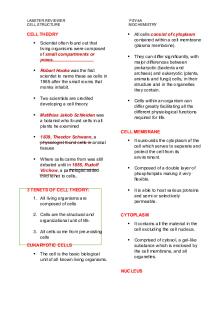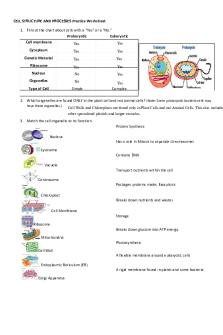Cell Structure and fucntion part 1 PDF

| Title | Cell Structure and fucntion part 1 |
|---|---|
| Course | Bachelor of Nursing |
| Institution | Victoria University |
| Pages | 14 |
| File Size | 1.1 MB |
| File Type | |
| Total Downloads | 67 |
| Total Views | 154 |
Summary
cell structure and function part1 notes...
Description
Anatomy and Physiology Cell Structure and Function Session 2 •Cell theory –A cellis the structural and functional unit of life –How well the entire organism functions depends on individual and combined activities of all of its cells –Structure and function are complementary • Biochemical functions of cells are dictated by shape of cell and specific subcellular structures –Continuity of life has cellular basis • Cells can arise only from other preexisting cells Cell Diversity •The cell is the smallest structural and functional living unit. •There are over 200 different types of human cells. •Types differ in size, shape, subcellular components, and functions
Intro to Cells Cytology is a branch of cell biology •The study of cells •Sex cells (germ cells or reproductive cells) •Male sperm •Female oocytes(cells that develop into ova) •Somatic cells •All body cells except sex cells
Generalised Cell All cells have some common structures and functions Plasma membrane: flexible outer boundary Cytoplasm: intracellular fluid containing organelles Nucleus: control center (contains DNA)
Extracellular Materials •Substances found outside cells •Classes of extracellular materials include: –Extracellular fluids (body fluids), such as: •Interstitial fluid: cells are submersed (bathed) in this fluid •Blood plasma: fluid of the blood •Cerebrospinal fluid: fluid surrounding nervous system organs –Cellular secretions (e.g., saliva, mucus) –Extracellular matrix: substance that acts as glue to hold cells together
Plasma Membrane •Acts as an active barrier separating intracellular fluid (ICF) from extracellular fluid (ECF) •Plays dynamic role in cellular activity by controlling what enters and what leaves cell •Also known as the “cell membrane” •Consists of membrane lipids that form a flexible lipid bilayer •Specialized membrane proteins float through this fluid membrane, resulting in constantly changing patterns –Referred to as fluid mosaic (made up of many pieces) pattern •Surface sugars form glycocalyx •Membrane structures help to hold cells together through cell junctions
Membrane Lipids •Lipid bilayer is made up of: –75% phospholipids, which consist of two parts: •Phosphate heads: are polar (charged), so are hydrophilic (water-loving) •Fatty acid tails: are nonpolar (no charge), so are hydrophobic (water-hating) –5% glycolipids •Lipids with sugar groups on outer membrane surface –20% cholesterol •Increases membrane stability
Membrane Proteins •Allow cell communication with environment •Make up about half the mass of plasma membrane •Most have specialized membrane functions •Some float freely, and some are tethered to intracellular structures •Two types: –Integral proteins; peripheral proteins •Integral Proteins –Firmly inserted into membrane –Most are transmembrane proteins (span membrane) –Have both hydrophobic and hydrophilic regions •Hydrophobic areas interact with lipid tails •Hydrophilic areas interact with water –Function as transport proteins (channels and carriers), enzymes, or receptors •Peripheral proteins –Loosely attached to integral proteins –Include filaments on intracellular surface used for plasma membrane support –Function as: •Enzymes •Motor proteins for shape change during cell division and muscle contraction •Cell -to -cell connections
Cytoplasm •All cellular material that is located between the plasma membrane and the nucleus –Composed of: •Cytosol: gel-like solution made up of water and soluble molecules such as proteins, salts, sugars, etc. •Inclusions: insoluble molecules; vary with cell type (examples: glycogen granules, pigments, lipid droplets, vacuoles, crystals) •Organelles: metabolic machinery structures of cell; each with specialized function; either membranous or nonmembranous
Organelles within the Cytoplasm Organelles –Nonmembranous organelles •No membrane •Direct contact with cytosol •Include the cytoskeleton, centrioles, ribosomes, proteasomes, microvilli, cilia, and flagella –Membranous organelles •Isolated from cytosol by a plasma membrane •Endoplasmic reticulum (ER), the Golgi apparatus, lysosomes, peroxisomes, and mitochondria Cytoplasmic Organelles Mitochondria •Double-membrane structure •Mitochondrial energy production •Aerobic metabolism (cellular respiration) - Mitochondria use oxygen to break down food and produce ATP •Produces 95 percent of ATP needed to keep a cell alive
Ribosomes •Site of protein synthesis (contain protein & RNA) •Links amino acids together to make proteins •Proteins are either used in the cell to make cell structures or exported from the cell
Endoplasmic Reticulum (ER) •Smooth ER •Rough ER (contains ribosomes)
Rough Endoplasmic Reticulum •Studded with ribosomes •Manufactures (synthesises) proteins •Including plasma membrane integral proteins and phospholipids Smooth Endoplasmic Reticulum •synthesises lipids (steroid hormones) •lipid and cholesterol metabolism (liver cells) •absorption, synthesis and transport of fats (Intestinal cells) •storage and release of calcium (In skeletal and cardiac muscle
Golgi Apparatus Stacked and flattened membranous sacs Modifies and packages proteins •Also involved in the transport of lipids and lysosome formation •Transport vessels from ER fuse with the Golgi apparatus
Lysosomes Spherical bags containing digestive enzymes (acid hydrolases) •Digest bacteria, viruses, and toxins (Intracellular digestion) •Degrade non-functional organelles •Destroy cells in injured or non useful tissue (auto-lysis) •Break down and release glycogen (glucose storage molecule) •Break down bone to release calcium
Peroxisomes Peroxisomes: are membranous sacs containing powerful oxidases and catalases to detoxify harmful or toxic substances. Contain Antioxidants that neutralize dangerous free radicals
Cytoskeleton •An elaborate series of filaments and tubules that extend throughout the cytoplasm. •Cellular support: gives shape to the cell and resistance to deformation (stability), stabilising the tissue.
Cellular Extensions Cilia and flagella •Cilia are short, hair-like projections that extend from the surface of the cell •move substances across cell surfaces e.g. respiratory tract, cells that line the uterine tubes •Flagella (longer) propel whole cells (tail of sperm) Microvilli •Fingerlike extensions of the plasma membrane •Increases surface area for absorption (eg. Small intestine)
Nucleus •Genetic library with blueprints for nearly all cellular proteins •Responds to signals that dictates the kind of proteins & the amount of proteins to be made •Most cells are uni-nucleate •Red blood cells are a-nucleate (no nucleus) •Skeletal muscle cells, bone destruction cells, and liver cells are multi nucleate
Nuclear Envelope •Double-membrane barrier containing pores (regulates the transport of molecules into and out of nucleus) •Inner lining maintains shape of nucleus •Outer layer is continuous with the Rough Endoplasmic Reticulum (contains ribosomes)
DNA, Chromatin, Chromosomes
Protein Synthesis DNA: is the master blueprint for protein synthesis. DNA transfers its coded information to a molecule called messenger RNA (mRNA)= Transcription mRNA: exits the nucleus through pores in the nuclear envelope and travels to the cytoplasm, where it binds to a ribosome. Ribosomes: move along the mRNA, translating the genetic message into a protein with a specific amino acid sequence= Translation...
Similar Free PDFs

Cell Structure and fucntion part 1
- 14 Pages

Cell Structure SE 1
- 3 Pages

Labster 1 cell structure
- 10 Pages

Cell Structure and Magnification PPQ
- 28 Pages

1.b Cell Structure Worksheet
- 1 Pages

Cell Structure (reviewer)
- 7 Pages

Structure of generalized cell
- 2 Pages

Cell Structure Worksheet
- 1 Pages

Cell Structure notes
- 13 Pages

Cell Structure Practice
- 3 Pages

CELL Structure OF Microorganisms
- 7 Pages
Popular Institutions
- Tinajero National High School - Annex
- Politeknik Caltex Riau
- Yokohama City University
- SGT University
- University of Al-Qadisiyah
- Divine Word College of Vigan
- Techniek College Rotterdam
- Universidade de Santiago
- Universiti Teknologi MARA Cawangan Johor Kampus Pasir Gudang
- Poltekkes Kemenkes Yogyakarta
- Baguio City National High School
- Colegio san marcos
- preparatoria uno
- Centro de Bachillerato Tecnológico Industrial y de Servicios No. 107
- Dalian Maritime University
- Quang Trung Secondary School
- Colegio Tecnológico en Informática
- Corporación Regional de Educación Superior
- Grupo CEDVA
- Dar Al Uloom University
- Centro de Estudios Preuniversitarios de la Universidad Nacional de Ingeniería
- 上智大学
- Aakash International School, Nuna Majara
- San Felipe Neri Catholic School
- Kang Chiao International School - New Taipei City
- Misamis Occidental National High School
- Institución Educativa Escuela Normal Juan Ladrilleros
- Kolehiyo ng Pantukan
- Batanes State College
- Instituto Continental
- Sekolah Menengah Kejuruan Kesehatan Kaltara (Tarakan)
- Colegio de La Inmaculada Concepcion - Cebu




